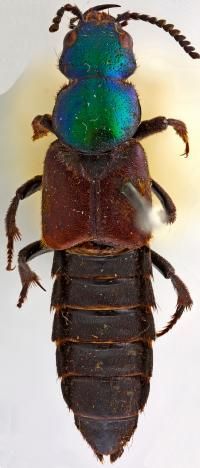Darwin Beetle Species Rediscovered 180 Years After Being Found, ‘Darwinilus Sedarisi’ Is ‘Truly Amazing’ [PHOTO]

Charles Darwin just received a birthday present, more than a century after his death.
One of the beetles collected from Darwin’s 1832 expedition to Bahia Blanca, Argentina, has been identified. On the 205th anniversary of his birth on Feb. 12, scientists named the genus and species after the famous naturalist: Darwinilus sedarisi.
“I received on loan several insects from the Museum in London, and to my surprise I realized that one of them was collected by Darwin,” said Dr. Stylianos Chatzimanolis, an entomologist at the University of Tennessee at Chattanooga and author of the study published in ZooKeys. “Finding a new species is always exciting. Finding one collected by Darwin is truly amazing.”
The specimen was considered lost for years until it was rediscovered in 2008. Only two known specimens exist of this newly named species – both collected before 1935. The second one was found in Rio Cuarto, a city in Argentina's province of Cordoba.
"Much of the area between Baha Blanca and Rio Cuarto has been converted into agricultural fields, and it is questionable if that is a suitable habitat for the species," Chatzimanolis wrote in his description of the species. "One of course hopes that a newly described species is not already extinct."
Darwinilus represents a new genus of rove beetles, the largest known beetle family, which are characterized by their short elytra that leave more than half of their abdomens exposed. Darwinilus has a bright metallic green color, sawtoothed antennas and a hexagonal-shaped head.
“I was both in awe and scared to death handling the specimen, so I really tried to minimize time spent handling it,” Chatzimanolis wrote in his blog about the discovery, explaining why it was not cleaned. “I know I could have very easily cleaned the specimen with a fine paintbrush. But in a specimen as old as this, who am I to say that the dust does not belong there, especially when it does not affect the specimen description?”
The second half of Darwinilus’ name is dedicated to author-performer David Sedaris. "I spent many hours listening to Mr. Sedaris' audiobooks while preparing the specimens and the figures for this and other manuscripts," Chatzimanolis said.
As for the discovery, Chatzimanolis says Darwin’s own words can best describe the feelings surrounding the new find.
"There is a famous Darwin quote about beetles," he told National Geographic. Darwin "said that 'Whenever I hear of the capture of rare beetles, I feel like an old war-horse at the sound of a trumpet.' I think Darwinilus sedarisi certainly qualifies as such a discovery."
© Copyright IBTimes 2024. All rights reserved.






















